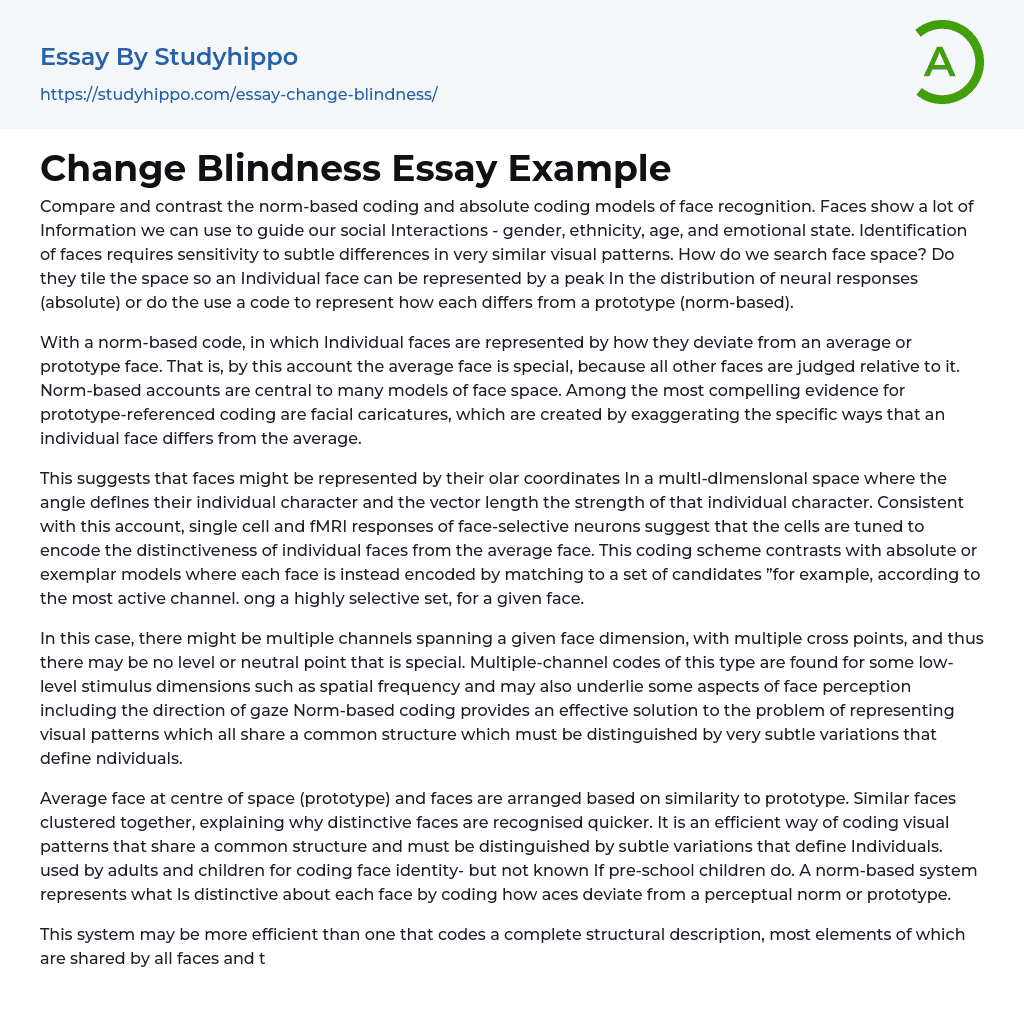Compare and contrast the norm-based coding and absolute coding models of face recognition. Faces show a lot of Information we can use to guide our social Interactions - gender, ethnicity, age, and emotional state. Identification of faces requires sensitivity to subtle differences in very similar visual patterns. How do we search face space? Do they tile the space so an Individual face can be represented by a peak In the distribution of neural responses (absolute) or do the use a code to represent how each differs from a prototype (norm-based).
With a norm-based code, in which Individual faces are represented by how they deviate from an average or prototype face. That is, by this account the average face is special, because all other faces are judged relative to it. Norm-based accounts are central to many models of face space. Among the most compelling evidence
...for prototype-referenced coding are facial caricatures, which are created by exaggerating the specific ways that an individual face differs from the average.
This suggests that faces might be represented by their olar coordinates In a multl-dlmenslonal space where the angle deflnes their individual character and the vector length the strength of that individual character. Consistent with this account, single cell and fMRI responses of face-selective neurons suggest that the cells are tuned to encode the distinctiveness of individual faces from the average face. This coding scheme contrasts with absolute or exemplar models where each face is instead encoded by matching to a set of candidates ”for example, according to the most active channel. ong a highly selective set, for a given face.
In this case, there might be multiple channels spanning a given face
dimension, with multiple cross points, and thus there may be no level or neutral point that is special. Multiple-channel codes of this type are found for some low-level stimulus dimensions such as spatial frequency and may also underlie some aspects of face perception including the direction of gaze Norm-based coding provides an effective solution to the problem of representing visual patterns which all share a common structure which must be distinguished by very subtle variations that define ndividuals.
Average face at centre of space (prototype) and faces are arranged based on similarity to prototype. Similar faces clustered together, explaining why distinctive faces are recognised quicker. It is an efficient way of coding visual patterns that share a common structure and must be distinguished by subtle variations that define Individuals. used by adults and children for coding face identity- but not known If pre-school children do. A norm-based system represents what Is distinctive about each face by coding how aces deviate from a perceptual norm or prototype.
This system may be more efficient than one that codes a complete structural description, most elements of which are shared by all faces and therefore redundant. Moreover, face norms are updated by experience, fine-tuning our face perception coding mechanisms to our diet of faces. A variety of behavioural and neurophysiological evidence supports use of norm-based coding for facial identity in adults. However, absolute-based coding allows a face to be averaged but the average has no place in the coding process.
The rocess involved encoding a stimulus face as a location in the multidimensional space (face space) and determining whether this location matches that of a known face. It is however not without
errors, errors here could depend on viewing time and inversion etc. Matching could be affected by magnitude of error and the proximity of nearby faces. These factors affect the probability that a new face will match the location of a known face and give rise to a false positive response.
- Adaptation essays
- Adventure essays
- Adversity essays
- Aging essays
- Alcohol essays
- Barbie Doll essays
- Beauty essays
- Care essays
- Carpe diem essays
- Change essays
- Chess essays
- Chicken essays
- Choices essays
- Contrast essays
- Crops essays
- Development essays
- Dream essays
- Evil essays
- Experience essays
- Family essays
- Farm essays
- Fire essays
- First Love essays
- Focus essays
- Greed essays
- Hero essays
- Holiday essays
- House essays
- Housing essays
- Humility essays
- Humor essays
- Hypocrisy essays
- Integrity essays
- Law of Life essays
- Life Changing Experience essays
- Life Experience essays
- Lifestyle essays
- Limitations essays
- Love Story essays
- Mother Tongue essays
- Motherhood essays
- My Neighborhood essays
- Myself essays
- Mystery essays
- Narcissism essays
- Never Give Up essays
- Nursing essays
- Object essays
- Opportunity essays
- Peel essays




